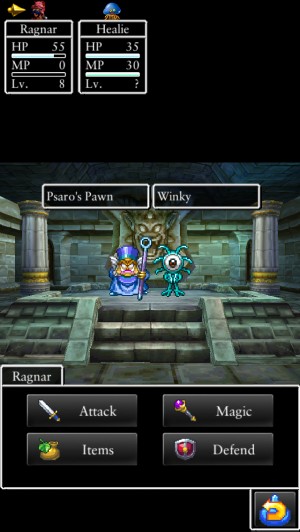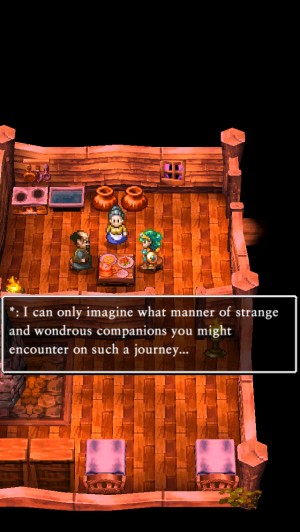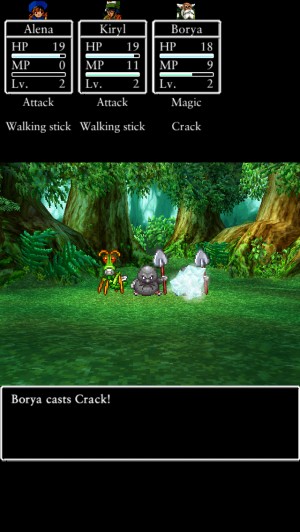 Dragon Quest IV ($14.99) is one of my favorite games in the entire Dragon Quest series. That also makes it one of my favorite RPGs, and by extension, one of my favorite games. Every time I run through this game, I find myself impressed that a game of this vintage hasn’t lost even a bit of its shine. Dragon Quest IV does many interesting things, some of which are rare even today. As a result, while a lot of elements of this game are going to feel familiar to RPG fans, there’s still nothing else quite like it, even with nearly 25 years of road behind it. So, you know clearly now where I stand concerning this game, but that’s not much use to you without telling you why I think so highly of this game.
Dragon Quest IV ($14.99) is one of my favorite games in the entire Dragon Quest series. That also makes it one of my favorite RPGs, and by extension, one of my favorite games. Every time I run through this game, I find myself impressed that a game of this vintage hasn’t lost even a bit of its shine. Dragon Quest IV does many interesting things, some of which are rare even today. As a result, while a lot of elements of this game are going to feel familiar to RPG fans, there’s still nothing else quite like it, even with nearly 25 years of road behind it. So, you know clearly now where I stand concerning this game, but that’s not much use to you without telling you why I think so highly of this game.
First, for the people who already love Dragon Quest IV and simply want to know how the port to iOS worked out, let me assure you that the game got a fine treatment. It’s based off of the DS version, which itself was based on the PlayStation 1 remake using Dragon Quest VII‘s engine. It uses a combination of 3D backgrounds and 2D characters and objects. The 3D backgrounds look better than they ever have, having been bumped up to mobile screen resolution. The sprites do not enjoy such benefits, and are presented as they were designed, at a relatively low resolution. The sprite elements look very pixelated on retina screens, with the sharper backgrounds making them stand out even more. I prefer this route over a filter, but your mileage will vary, of course.
 The game plays in portrait mode, and when outside of battle, the whole screen is filled. The battles are windowed, filling out the blank areas at the top and bottom of the screen with status messages and the UI. This has the pleasant side effect of making the wonderfully-animated enemy sprites look better, since their pixels aren’t being blown up any more than they have to be. One annoying change in this version is that when you return from a battle, the background music resets rather than continuing from where it left off. Combined with the somewhat high encounter rate, you’re going to be hearing the openings of songs quite frequently, and the whole piece very rarely.
The game plays in portrait mode, and when outside of battle, the whole screen is filled. The battles are windowed, filling out the blank areas at the top and bottom of the screen with status messages and the UI. This has the pleasant side effect of making the wonderfully-animated enemy sprites look better, since their pixels aren’t being blown up any more than they have to be. One annoying change in this version is that when you return from a battle, the background music resets rather than continuing from where it left off. Combined with the somewhat high encounter rate, you’re going to be hearing the openings of songs quite frequently, and the whole piece very rarely.
On a positive note, the party chat, cut from the previous Nintendo DS English version, has been fully restored in the iOS version. These are little optional conversations you can have with your party members, and they go a long way towards filling out their personalities. Finally, the game naturally uses touch controls, a similar one-handed style set-up to the iOS version of Dragon Quest VIII ($19.99). Since the game requires very little movement of the camera, a sticking point for some in DQVIII, the controls should be more agreeable for everyone in this installment. In all other respects, this is the same game as the Nintendo DS version. All of the content is here, including the extra chapter and playable characters, with no added cost. It also runs silky smooth, which ought to be good news for people who had some issues with the last Dragon Quest game on iOS.
As to the game itself, there are a lot of reasons why I think this is a very special adventure. First of all, this game has what is, in my opinion, the strongest cast of party members in the entire series. Dragon Quest usually has somewhat weak characterization among the playable roster, but Dragon Quest IV is a huge exception. By the end of the game, you’ll have nine permanent members in your party, with several more temporary members having come and gone. While some of the characters stand out a little bit more than others, such as Torneko Taloon, the merchant, you’ll get to know all of them very well thanks to the game’s unique structure.
 The subtitle of Dragon Quest IV is Chapters of the Chosen, because the story is broken up into six chapters, each with their own title and ending card. Each of the first four chapters focuses on one or more of the party members, giving them their own story and establishing their reasons for eventually meeting up and joining with the hero. In the original NES version, you didn’t even meet the hero until you finished the first four chapters, but in the remakes a very brief prologue was added so that you aren’t left wondering why you had to put in a name at the start. These chapters become increasingly complex as they go along, with the first one, centered on the soldier Ragnar McRyan, serving as a fairly basic tutorial for the game. After playing each chapter, you’ll move on to the next one, with a whole fresh batch of characters and a new area of the world to explore.
The subtitle of Dragon Quest IV is Chapters of the Chosen, because the story is broken up into six chapters, each with their own title and ending card. Each of the first four chapters focuses on one or more of the party members, giving them their own story and establishing their reasons for eventually meeting up and joining with the hero. In the original NES version, you didn’t even meet the hero until you finished the first four chapters, but in the remakes a very brief prologue was added so that you aren’t left wondering why you had to put in a name at the start. These chapters become increasingly complex as they go along, with the first one, centered on the soldier Ragnar McRyan, serving as a fairly basic tutorial for the game. After playing each chapter, you’ll move on to the next one, with a whole fresh batch of characters and a new area of the world to explore.
This pays off handsomely in the fifth chapter, where you finally take control of your hero and, one by one, gather up all of the characters you previously played as. Since they’re intimately familiar faces to you, the player, it’s rather interesting to run into them at first. You’ll be happy to see them, like running into an old friend, but of course they don’t know the hero from a hole in the wall, so they approach you as a stranger. It’s a fun little spin on the usual RPG narrative, where we tend to meet new party members in the middle of their own personal story and get to know them after the fact. Strangely, not many games have opted to borrow this system, and the ones that have, like Final Fantasy IV: The After Years ($14.99), have done it quite poorly and for all the wrong reasons.
 Since your party members are all defined characters with preset job classes, you don’t have a lot of choices for individual character customization, much like its rival, Final Fantasy IV ($14.99). Unlike the vanilla versions of that game, in Dragon Quest IV you can choose your active party members as you like once they’ve joined. You can even leave your hero off of the active team. While it’s certainly more limited than the excellent class systems found in some other Dragon Quest games, the large roster combined with the ability to pick your active team still gives you a lot of choice.
Since your party members are all defined characters with preset job classes, you don’t have a lot of choices for individual character customization, much like its rival, Final Fantasy IV ($14.99). Unlike the vanilla versions of that game, in Dragon Quest IV you can choose your active party members as you like once they’ve joined. You can even leave your hero off of the active team. While it’s certainly more limited than the excellent class systems found in some other Dragon Quest games, the large roster combined with the ability to pick your active team still gives you a lot of choice.
One of the other famous aspects of the original version of Dragon Quest IV was having the computer AI control your teammates. This was good for giving them a bit of extra personality, especially in the case of the buffoonish Torneko, but a lot of players found it frustrating that they couldn’t direct their team as they saw fit. In the remakes, this was walked back quite a bit. While you can choose to put them under AI control, by default all of your permanent party members are under your direct command. Temporary party members are still controlled by the computer, however, so you’ll just have to deal with that. Luckily, the AI is pretty smart for the most part, and you can give it broad directions like conserving MP, playing defensively, and so on.
The gameplay is standard Dragon Quest, with an overworld to traverse, towns, dungeons, and castles to explore, and turn-based random encounters aplenty. Since this is the remake, the experience points and gold gain have been tweaked a bit to reduce the need to grind, but you’re still going to have to play smart if you don’t want to run into any chokepoints. While the opening chapter of the game gives you a strong, hardy knight who doesn’t have many options other than bashing things into powder, later chapters will often give you physically weak characters with more magic and skill options, nudging you as hard as it can to learn some strategy. This element of the game also helps to keep things fresh, since until you get to the fifth chapter, you’re forced to work with whatever party the game gives you, with no two using quite the same strategy.
 The third chapter is particularly memorable. You play as the portly old merchant Torneko, and you’re going to have to toss out many of your RPG preconceptions for the duration of his tale. It’s not a terribly long chapter, and for many, it feels like it ends all too soon, but it’s exactly the palate cleanser the game needs at that stage of the quest. Just about everyone comes out of Dragon Quest IV loving Torneko, and I expect that rule to hold no matter how much time passes on this story. That’s not to say the rest of the quest is a slouch, with an excellent pace and strong world-building, but the third chapter is so unique that it really stands out.
The third chapter is particularly memorable. You play as the portly old merchant Torneko, and you’re going to have to toss out many of your RPG preconceptions for the duration of his tale. It’s not a terribly long chapter, and for many, it feels like it ends all too soon, but it’s exactly the palate cleanser the game needs at that stage of the quest. Just about everyone comes out of Dragon Quest IV loving Torneko, and I expect that rule to hold no matter how much time passes on this story. That’s not to say the rest of the quest is a slouch, with an excellent pace and strong world-building, but the third chapter is so unique that it really stands out.
This is all backed by a very bold localization that opts to give every region of the game its own unique accent of English. It’s a bit of a shock initially, since Ragnar McRyan’s homeland of Burland uses an incredibly thick Scottish dialect that is likely a bit confusing for the average English speaker. Still, I think the intention is to really hammer home the idea that this is a big world with a lot of different cultures in it, and that they all have to work together to build a good future for everyone. The localization also takes great delight in puns, but it generally fits the tone well. Some people will hate the accents and perhaps even the wordplay, while others are going to really get into both. Personally, I love it, but as you all know, my love of terrible puns nearly matches my love of video games, so take that with a grain of salt.
The game has a wonderful soundtrack, and it’s a shame the way they’ve set it up results in barely being able to hear so many tracks. It’s worth just chilling out on the map for a minute or two to take in a song completely before moving on. Every chapter has its own spin on the overworld and battle music, offering quite the musical variety. The graphics probably aren’t going to please everyone, with their 3D/2D combination that results in a strong feeling of visual inconsistency. At the very least, the enemy sprites have very fluid animation, with a lot of silly little touches that are in there just to add personality. There is also no controller support, so you’ll have to learn to like the touch controls. Since I love playing RPGs one-handed, I think the game plays excellently.
Opinions will vary on where this ranks in the series, but I personally feel it’s a better game than Dragon Quest VIII, though that game certainly has its strengths over this one. Dragon Quest IV is a more compact quest, running about 40 hours, but I think that’s still quite meaty, especially relative to other mobile RPGs. The game’s unique style of unrolling its story feels just as pleasantly unusual today as it did 25 years ago, and thanks to the restoration of the inter-party chatter, the memorable characters shine even brighter than they already did. If you like RPGs, this is a game you need to play. It’s a fantastic port of one of the true essentials of the genre.
Hey, I wrote all of those words without spelling ‘Dragon’ incorrectly even once. Do I get a prize?


